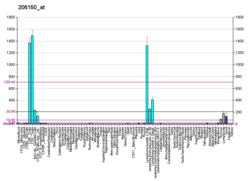CD27
CD27 is a member of the tumor necrosis factor receptor superfamily. It is currently of interest to immunologists as a co-stimulatory immune checkpoint molecule.
Function
The protein encoded by this gene is a member of the TNF-receptor superfamily. This receptor is required for generation and long-term maintenance of T cell immunity. It binds to ligand CD70, and plays a key role in regulating B-cell activation and immunoglobulin synthesis. This receptor transduces signals that lead to the activation of NF-κB and MAPK8/JNK. Adaptor proteins TRAF2 and TRAF5 have been shown to mediate the signaling process of this receptor. CD27-binding protein (SIVA), a proapoptotic protein, can bind to this receptor and is thought to play an important role in the apoptosis induced by this receptor.[5]
In murine γδ T cells its expression has been correlated with the secretion of IFNγ.[6]
Clinical significance
As a drug target
Varlilumab is an antibody that binds to CD27 and is an experimental cancer treatment.
References
- GRCh38: Ensembl release 89: ENSG00000139193 - Ensembl, May 2017
- GRCm38: Ensembl release 89: ENSMUSG00000030336 - Ensembl, May 2017
- "Human PubMed Reference:". National Center for Biotechnology Information, U.S. National Library of Medicine.
- "Mouse PubMed Reference:". National Center for Biotechnology Information, U.S. National Library of Medicine.
- "Entrez Gene: CD27 CD27 molecule".
- Ribot, Julie C; deBarros, Ana; Pang, Dick John; Neves, Joana F; Peperzak, Victor; Roberts, Scott J; Girardi, Michael; Borst, Jannie; Hayday, Adrian C; Pennington, Daniel J; Silva-Santos, Bruno (April 2009). "CD27 is a thymic determinant of the balance between interferon-γ- and interleukin 17–producing γδ T cell subsets". Nature Immunology. 10 (4): 427–436. doi:10.1038/ni.1717. ISSN 1529-2908. PMC 4167721. PMID 19270712.
- Prasad KV, Ao Z, Yoon Y, Wu MX, Rizk M, Jacquot S, Schlossman SF (Jun 1997). "CD27, a member of the tumor necrosis factor receptor family, induces apoptosis and binds to Siva, a proapoptotic protein". Proceedings of the National Academy of Sciences of the United States of America. 94 (12): 6346–51. doi:10.1073/pnas.94.12.6346. PMC 21052. PMID 9177220.
- Yamamoto H, Kishimoto T, Minamoto S (Nov 1998). "NF-kappaB activation in CD27 signaling: involvement of TNF receptor-associated factors in its signaling and identification of functional region of CD27". Journal of Immunology. 161 (9): 4753–9. PMID 9794406.
- Akiba H, Nakano H, Nishinaka S, Shindo M, Kobata T, Atsuta M, Morimoto C, Ware CF, Malinin NL, Wallach D, Yagita H, Okumura K (May 1998). "CD27, a member of the tumor necrosis factor receptor superfamily, activates NF-kappaB and stress-activated protein kinase/c-Jun N-terminal kinase via TRAF2, TRAF5, and NF-kappaB-inducing kinase". The Journal of Biological Chemistry. 273 (21): 13353–8. doi:10.1074/jbc.273.21.13353. PMID 9582383.
Further reading
- Lens SM, de Jong R, Hintzen RQ, Koopman G, van Lier RA, van Oers RH (Jun 1995). "CD27-CD70 interaction: unravelling its implication in normal and neoplastic B-cell growth". Leukemia & Lymphoma. 18 (1–2): 51–9. doi:10.3109/10428199509064922. PMID 8580829.
- Agematsu K (Apr 2000). "Memory B cells and CD27". Histology and Histopathology. 15 (2): 573–6. PMID 10809378.
- van Baarle D, Kostense S, van Oers MH, Hamann D, Miedema F (Dec 2002). "Failing immune control as a result of impaired CD8+ T-cell maturation: CD27 might provide a clue". Trends in Immunology. 23 (12): 586–91. doi:10.1016/S1471-4906(02)02326-8. PMID 12464570.
- Dörner T, Lipsky PE (2005). "Correlation of circulating CD27high plasma cells and disease activity in systemic lupus erythematosus". Lupus. 13 (5): 283–9. doi:10.1191/0961203304lu1014oa. PMID 15230280.
External links
- CD27+Antigens at the US National Library of Medicine Medical Subject Headings (MeSH)
- Human CD27 genome location and CD27 gene details page in the UCSC Genome Browser.




